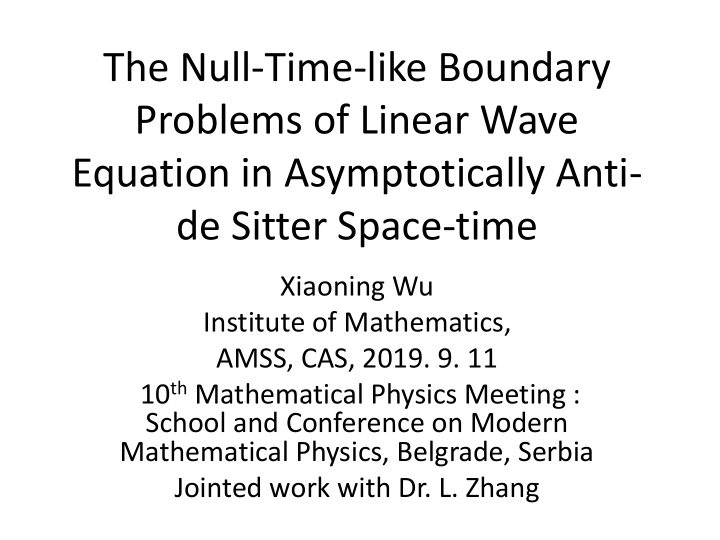



The Null-Time-like Boundary Problems of Linear Wave Equation in Asymptotically Anti- de Sitter Space-time Xiaoning Wu Institute of Mathematics, AMSS, CAS, 2019. 9. 11 10 th Mathematical Physics Meeting : School and Conference on Modern Mathematical Physics, Belgrade, Serbia Jointed work with Dr. L. Zhang
• Cauchy problem for linear wave equation • Similar result holds for Einstein equations ( Y. Choquet-Bruhat, 1950’)
• Characteristic initial value problem Impose initial data on two intersected null hypersurfaces. 1. Local existence : Z. Hagen, H. J. Seifert, 1977; H. Friedrich, 1980; A. Rendall, 1990 2. Finite region : J. Luk, 2011 3. Semi-global existence : X.-p. Zhu and J.-b. Li, 2016
• Null-time-like boundary value problem Impose initial and boundary data on intersected null hypersurface and time-like hypersurface.
1. R. Bartnik, 1996 : quasi spherical gauge. 2. R.Balean, 1997: linear wave equation in Minkowski space 3. R.Balean, R.Bartnik, 1998 : Maxwell equations in Minkowski space 4. Q. Han, L. Zhang, 2017 : linear wave equation in asymptotic flat space-time
• Physical Motivation : AdS/CFT correspondence 1. Investigate AdS/CFT in terms of boundary value problem ( Witten, 1998, 2018) 2. Holographic model of condensed matter, “3H” model (Hartnoll, Herzog and Horowitz, PRL, 2008) 3. Entropy production for holography (Bredberg, Keeler, Lysov and Strominger, JHEP, 2011; Tian, Wu and Zhang, JHEP, 2012) 4. Dynamical process with dissipation in holographic method
• Asymptotic AdS space-time Introduce new coordinates Conformal boundary : 𝑠 → ∞ (z = 0)
Region considered :
• Equation : • Boundary condition : • Boundary of the region :
• Conformal method then Boundary condition :
• Null tertad 2 for any fixed (𝜐, 𝑨) , denote correspondent 𝑇 2 as 𝑇 (𝜐,𝑨) ; denote 𝐼 𝜈 for the in-going null hypersurface 2 generated by 𝑂 2 and starts at 𝑇 (0,𝜈) .
• Main theorem : (Wu and Zhang, 2019)
Sketch of Proof : Local existence of solution Analytic approximation method 1. Consider problem for analytic coefficients and initial data. 2. Using analytic function to approximate general functions with the help of energy estimate.
Analytic case : Consider equations in the form with all coefficients are analytic. The initial data on time-like and null boundary is also analytic. define
Equation becomes Algebraic calculation implies
Solving the ODE for 𝑥 𝑗 , one can get all Taylor coefficients of 𝑣 𝑗 and w, which means one get formal solution of the analytic system. Using majorizing function method, one can prove above formal solution converge. Since the region is closed, one can use analytic function to approximate the smooth function. Now one needs to show if initial data 𝑄 𝑗 → 𝜒 and 𝑅 𝑗 → 𝜔 in 𝐼 2𝑙 space, and equation coefficients also satisfies 𝑗 → and 𝜕 𝑗 → 𝜕 , whether the associated solution 𝑣 𝑗 will converge to a solution u ?
Enenrgy estimate “Energy - momentum tensor” for 𝐷 1 function, One can construct current associated with vector X as Carefully choose vector field X and weight function h, integral above eqution on Ω 𝑈,0 and integral by part for left side, one can get if
Where is surface term on cosmologic horizon H
Higher order derivative estimate : Which implies for any 𝛽 = 𝑞 , Then
Finally, one has
Estimate on 𝑁 2 Since in Theorem 3.9 and 3.14, one has got the control for the data on H , one can use similar idea to control the data in 𝑁 2 in terms of the data on H and conformal boundary.
Since 𝑄 𝑗 , 𝑅 𝑗 , 𝑗 , 𝜕 𝑗 are all Cauchy sequences, with the control of corollary 3.17 and 3.20, 𝑣 𝑗 is a Cauchy sequence in 𝐼 𝑙 (𝑃(𝑇 (0,1/𝑆) )) obviously, so 𝑣 𝑗 → 𝑣 and u is a solution of equation (Here we use the linearity of equation). So one get the local existence of wave equation in some neighborhood of 𝑇 (0,1/𝑆) .
Global existence (Bootstrap method)
Discussion : 1. null-time-like boundary value problem of mass-less scalar field is proved, free data is the value of field on boundary and conformal boundary. 2. This result can be generalized to massive field, at least the field mass is small enough. 3. Similar result holds for Maxwell field. 4. Linear gravity is uneasy, since one need to deal with the gauge freedom. 5. Since asymptotic AdS space-time allows negative mass, it is interesting whether the negative mass will destroy these estimates ? 6. Final aim : how about for Einstein equation ?
Thank you
Recommend
More recommend